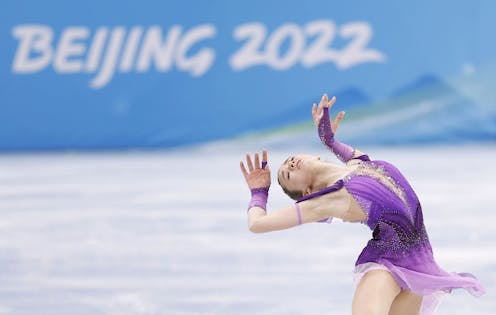
For dancers and ex-dancers like myself, the figure skating at the Winter Olympics is a particularly irresistible drawcard: the speed of the skating, the height of the jumps, the delicacy of the movements, the speed of the twirls and the musicality and interpretation of the skaters.
However, there are aspects of figure skating which seem odd to a dancer. Many of the jumps require the skater to be skating backwards before they jump – one would expect them to be facing in the direction in which they are going.
And despite the skater being applauded for maintaining a “good posture”, their overall bearing is bent forward with their bottoms stuck out. This is the antithesis of what a ballet dancer should do!
The costumes are generally glorious, giving the women an impression of fairylike fragility, but sometimes they are just that. Gabriella Papadakis and Guillaume Cizeron (France) learnt this to their dismay in 2018 when the top of Papadakis’ dress came apart, costing them the PyeongChang gold medal.
Skating boots, too, have always seemed very clumsy to my dancer’s eye. There is no ability to elegantly point the feet and consequently no beautifully stretched calf muscles.
Originality is key with the music. Something novel will delight the audience but often we get the same old favourites like Ravel’s Bolero, Tchaikovsky’s Swan Lake and Puccini’s Turandot.
Sometimes the music is so weird and wonderful there is no easily identifiable tune or melody with which the audience can identify – or beat or musical phrasing that is predictable and comforting to the audience. (This is less the case when pairs skate together. The risk of lack of synchronisation is probably too high.)
The expression and musicality of the skater determines the extent to which their skating becomes much more: a vehicle for true passion. Unfortunately, despite being technically brilliant, many skaters lack the ability to portray emotion right from their core and their performance can leave the audience impressed but untouched.
But there are some stars at Beijing who manage to combine their incredible skating skills with a real passion for performance and interpretation of the music. Here are my top skaters to look out for.
Nathan Chen (USA)
Nathan Chen’s musicality is good, but even he admits he is not the most emotional of skaters. Often the emotion expressed in his body and arms just doesn’t follow through to his hands and fingertips, which seem to hang in an uninspired fashion.
But he is the consummate technical skater, already wowing audiences with his quad Lutz-triple toe combination jump in the teams event with a winning score of 111.71
His performance is neat, precise and accurate, executing all the technical aspects superbly and throwing in a number of challenging quad jumps. The latter he executes with blurring speed and neat, solid landings with an erect back.
Jason Brown (USA)
Jason Brown has been described as the “ultimate dancers’ skater”.
Lean and long-limbed with very high leg elevation, he uses his body from the core of his gut right through to the tips of his fingers and feet in the most expressive and captivating manner. He takes his audience with him every moment of the performance.
Unfortunately, he is at a disadvantage to much of his competition, as he typically doesn’t do the high-scoring quad jumps.
Yuzuru Hanyu (Japan)
Yuzuru Hanyu, past winner of two Olympic gold medals, is a good combination of a Chen and Brown – beautiful execution with the dazzling brilliance of quad jumps as well as passionate feeling.
He possesses natural poise so with his upright back and beautifully deep plié when he lands, one never feels in any doubt a rotating jump will not succeed. Plus, his emotion extends right to his fingertips.
This is certainly a contestant to watch.
The Russian women
No one can deny the spectacular performances of all three women on the ROC team: Kamila Valieva (age just 15), Anna Shcherbakova (17) and Alexandra Trusova (17).
These three young skaters are quite spellbinding. Lean and long-limbed, their superb leg elevation and exquisite feeling is nothing short of astonishing. Add to that some exceptional jumps – including quads – which spin at such a speed they are just a blur as they whizz round.
Small wonder Valieva has already done so well in the teams event.
The skating pairs
While the individual performances are impressive, one should not forget the pairs. The US ice dance pair, Madison Hubbell and Zachary Donohue, have already done themselves proud. Their musicality and feeling, their obvious empathy with one another propelled them easily into the lead in the rhythm component of the teams event. They demonstrate the synchronicity of interpretation of which Torvill and Dean were such masters.
The equally talented Victoria Sinitsina and Nikita Katsalapov (ROC) are snapping at their heels, so this competition will be one to watch.
Two other pairs are also worth watching: Gabriella Papadakis and Guillaume Cizeron (France) and Tessa Virtue and Scott Moir (Canada). Both couples are highly skilled technically and provide consistently superb interpretations of their music.
However, Virtue and Scott possess a vivacity that seems to make them sparkle, which to possibly will give them the edge.
Val Hooper does not work for, consult, own shares in or receive funding from any company or organization that would benefit from this article, and has disclosed no relevant affiliations beyond their academic appointment.
This article was originally published on The Conversation. Read the original article.







